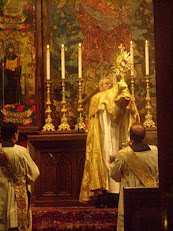Q: What reforms did we see that were never intended by the document or were taken too far?What was never intended, or imagined, by the Council Fathers was Communion in the hand and receiving Communion standing. These practices began in the Netherlands soon after the Council, and, later, they were authorized, a shameful episode when breaking law led to making law. Can anyone seriously argue that these practices have deepened reverence for the blessed Eucharist?Read the rest at the web site of NCR.
Then we come to what was never mentioned in Sacrosanctum Concilium, but soon spread everywhere after the Council — Mass facing the people. I eagerly supported that change, and I celebrate most Masses that way.
But now, after much reflection, I have second thoughts. Has this overemphasized the priest? Does it rest on the erroneous opinion that the Mass is a meal? Have we lost something? The mystery? So what was gained by all that expensive renovation of sanctuaries? We moved altars — but did we move hearts?
In a broader perspective, what really set in was the secularization of the liturgy. That led to the degradation of language, rituals, vessels and vestments, design, architecture and music.
The Mass became a dialogue across a table, and Communion became a queue when people go and get something. Please do not tell me that a queue is a “Communion procession.”
Now, we face the urgent need to recover the sacred because Sacrosanctum Concilium never intended to secularize Christian worship, with all that dull ugliness and cold functionalism. As Pope Benedict taught, beauty is essential in all that pertains to the worship of the God, who is Beautiful, and that rests on Chapter 7 of Sacrosanctum Concilium.
Hat tip to Mary Ann Mueller.














No comments:
Post a Comment